|
I.S.S.F.
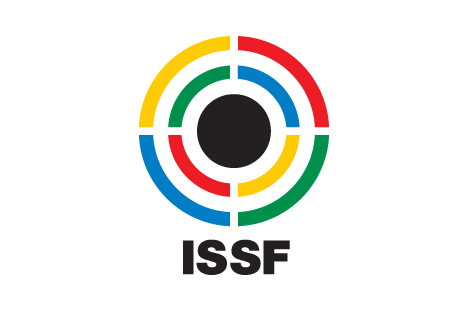

|
THE EQUIPMENT
|
Spotting Scope
These mini spotting scopes are ideal for anything from 10m airgun to 50m Free Pistol or small bore rifle under even in low light.
The 45 degree angled eyepiece is adjustable around 360 degrees; spot from the left, spot from the right, you choose.
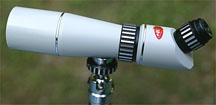
|

| Glasses
|
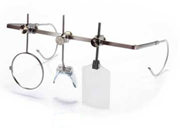
|
Typically with 37mm lens holder, opaque eye-cover and carrying case. Lens placement is fully adjustable in every direction to make the most of your corrective optics no matter what your head position. These glasses are available for left or right eyed shooter. |
Free Pistol
|
50m Free Pistol is the toughest of the Olympic shooting events. Of course it may be a frustrating discipline to master, but when things go right there is no more satisfying feeling than holding ten shots within the 4-inch nine ring. Why not the ten ring? If that question entered your head you're either a hopeless optimist or have never shot much Free Pistol
|

|
The rules for Free Pistol are quite simple. As the term would suggest, there are few restrictions on the pistol used. It has to be a .22 caliber rimfire pistol with open sights. The grip may not contact the hand beyond the wrist. There are no restrictions on barrel length, sight radius or trigger weight, although the pistol must be set off by the trigger finger of the shooting hand. A repeater may be used but one round must be loaded at a time. Match duration is a limit of two hours for 60 shots, with unlimited sighters (all of which must be fired before the first competition shot). Targets are the same as used for 25m Standard Pistol and the Precision section of Sport Pistol and Center Fire except shot at twice the distance. And as with all ISSF events we stand on our hind legs and shoot like real men (and women) one handed.
Air Pistol
|

|
In the 10m Air Pistol events, shooters may take an unlimited number of Sighting Shots before they start shooting for record. Once the first Record Shot is fired, the shooter cannot take any more sighting shots. The only exceptions are rare instances when there is a gun malfunction that cannot be fixed on the line or the range is shut down for some reason.
|
Shooters can take as much time as they like within the time limit. They may shoot at their own pace. They may take breaks as they wish. Shooters may Dry Fire at any time from the start of the Preparation Period until the match time limit has expired.
International and Major matches are typically fired on Electronic Targets. When Electronic Targets, or automatic target changers for paper targets are used, the shooters are given the full time limit without interruption. The shooter can fire as many sighting shots as desired and when ready, press a button to start Shooting for Record. If the match is divided into two or more segments to facilitate target changing, the time segments for shooting still total the full time.
When Electronic Targets or automatic target changers are not available, the time limit will typically be divided into smaller segments and Paper Targets will be changed between time periods. In this case shooters are typically given one time period for sighter shots, then the entire line changes targets and starts shooting for record. Sometimes two or more targets will be hung and a longer time interval used. In this case shooters may be given one sighter target and one (or more) record target for the first time interval.
Range Commands
Preparation Time Begins Now
after 10 minutes
Start
10 minutes before the completion of shooting time
10 minutes
5 minutes before the completion of shooting time
5 minutes
at the completion of shooting time
Stop
Rules
General
The rules are straight-forward:
Other than the number of competition shots and the time allowed, the Mens and Womens events are the same:
Men shoot a 60-shot match in a time allowance of 1 hour 45 minutes
Women shoot a 40-shot match in a time allowance of 1 hour 15 minutes
The pistol must be loaded one shot at a time.
The shooter must shoot one handed and use the same hand to support and trigger the gun.
The shooter cannot wear clothing that offers additional support.
Malfunctions
to be added
Pistol Specifications
4.5 mm (177") calibre Air Pistol
Powered by compressed air or gas
Fit in a box 420 x 150 x 50 mm
Maximum weight 1500 grams
Minimum trigger pull 500 grams
Sights 'open' metallic only
Grip
The grip cannot touch beyond the hand; i.e. the wrist must be visibly free when the pistol is held in the normal firing position.
may not start to encircle hand when viewed longitudinally
Ported barrels are allowed
Ammunition
4.5 mm lead projectiles
Standard Shoots and their Targets
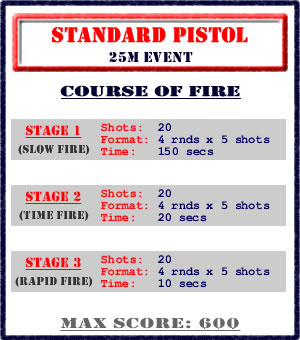 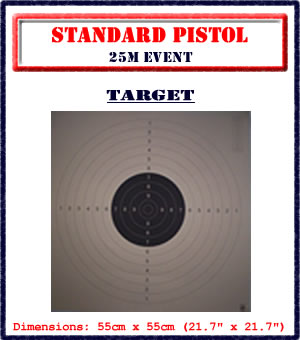
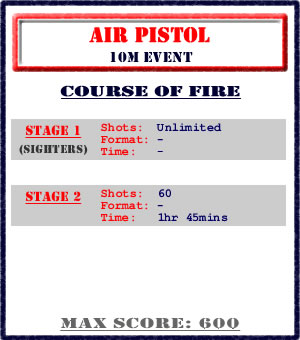 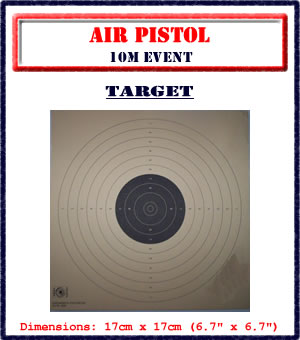
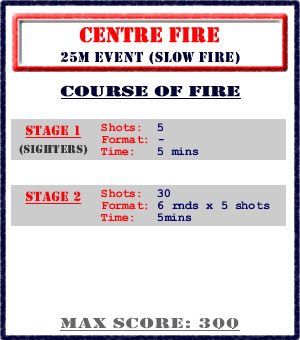 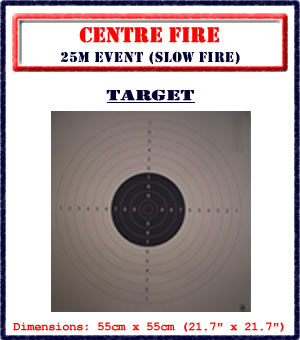
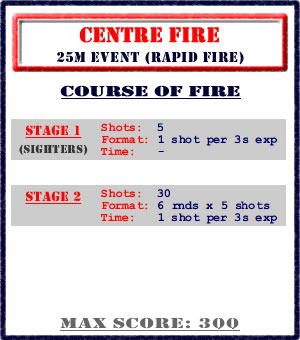 
History
19th century During the 19th century, earlier forms of organizations such as shooting clubs developed into national shooting federations. The Socit Suisse des Carabiniers was founded in 1824 in Switzerland; Queen Victoria inaugurated the British National Rifle Association in 1859. Duke Ernst II of Saxony-Coburg and Gotha founded the Deutscher Schtzenbund in 1861, and military leaders established the National Rifle Association of America (USA) in 1871.
The Federation Francaise des Societies de Tir was formally established in 1884, but earlier French national federations had preceded it.
1896 The shooting sport began part of the modern Olympic Family since its first steps. In the first Olympic Games, held in Athens in 1896, 39 shooters from seven nations competed in three pistol and two highpower rifle events. Shooting also was included in the program of the second Olympic Games where 139 shooters from 13 nations competed in three pistol, five rifle, two clay target and one running target events.
1907 On 17 July 1907, representatives of seven national shooting federations, six from Europe (Austria, Belgium, France, Greece, Italy, Holland) and one from South America (Argentina), met in in Zurich, Switzerland, to formally establish the LUnion Internationale des Fdrations et Associations nationals de Tir (International Union of National Shooting Federations and Associations) in a meeting that would be remembered as the first ISSF General Assembly.
The President of LUnion des Socits de Tir de France, Daniel Mrillon, a 55-year old lawyer from Paris, was elected as the first ISSF President.
1908 The second General Assembly of the ISSF history took place in Vienna, during the International Matches. Three new member federations from England, Germany and Hungary, were also represented. The Swiss shooting federation, after the first indecisions, joined the union at the General Assembly. Later on, during the year 1908, USA would join the union. Yet another interesting event was the formation of BRPF.
1909 The shooting family grows, and more national federations join the union. Between 1909 and 1914, Serbia, Denmark, Spain, Portugal, Sweden, Peru, Mexico and Finland become members of the Union Internationale, following the desire by the first ISSF leaders to make their organization a world sports federation.
1912 284 shooters, coming from 16 different countries, participated in the 1912 Olympic Games of Stockholm, Sweden, in 15 total events, two pistol, eight rifle, two shotgun and three running target.
1916 The 1st World War in Europe caused the cancellation of the 1916 Olympic Games which were to take place in Berlin, and the next ISSF International Matches which were to take place in 1916. President Mrillon circulated a written proposal to the member federations and the decision was made, by a vote of ten to six, to dissolve the Federation. LUnion des Socits de Tir de France was entrusted with the care of the ISSF records and property.
1920 President Mrillon invited the national federations that were members in 1915 and federations representing new countries formed after the war to come to a meeting in Paris on 16 April 1920 to renew ISSF activities. Delegates from 14 countries attended and agreed to reestablish the ISSF under the name LUnion Internationale de Tir (UIT). Mrillon was reelected President of the Union.
1920 The 1920 Olympics of Antwerp saw 21 shooting events in its program, the highest number of events in Olympic history. 18 nations participated with 233 athletes.
1921 IOC International Olympic Committee - decided in 1921 that ISSF regulations were to govern the shooting events in the 1924 Games. This was the first concrete step in forging a union between the ISSF and the IOC that was to have such a profound impact on the Federations future.
1924 The shooting events of the Paris Olympiad used ISSF regulations and were organized by LUnion des Socits de Tir de France. Over 260 athletes from 27 nations participated in the Olympic shooting events.
1927 After the premature death of Mrillon, his son-in-law Jean Carnot was elected as the second ISSF President in a divided vote at the General Assembly held in Rome in 1927.
1928 - A crisis in the ISSFs relationship with the IOC occurred between the years 1926 and 1928. The practice of awarding money prizes in ISSF World Championships clashed with strict IOC amateur standards. As a result, the IOC excluded shooting from the 1928 Olympic Games in Amsterdam. At its 1928 General Assembly, ISSF delegates approved an appeal to the IOC to reinstate shooting to the 1932 Olympic Games program.
1932 - Shooting was re-included on the Olympic program of the Games of Los Angeles, but the number of the events was greatly reduced. There were only two shooting events, one rifle and one pistol. 41 athletes from 10 countries took part, but many of the worlds best marksmen were not there because their acceptance of money prizes in other competitions made them incompatible with the IOC amateur standards.
1936 - Shooting was again on the Olympic program in Berlin in 1936, this time with three events, a smallbore rifle 50 meter 30-shot prone event and two pistol events, the traditional 50 meter free pistol event and the new 25 meter rapid-fire pistol event that had been tested at the 1933 World Championship.
1937 The year 1937 saw the first participation of a Woman in an open World Championship event. Catherine Woodring fired as a member of the USA team, winning the 50-meter rifle prone gold team medal.
1940 Olympic Games of Helsinki could not take place: the Second World War was exploded. For the second time in the ISSFs short history, a decision was made to suspend operations.
The ISSF records and archives were transported by Karl August Larsson, Secretary General of the Swedish shooting federation, from Paris to Stockholm, where they could be protected in a neutral nation.
1947 After the conclusion of the Second World War, eight member federations agreed on holding a World Championship and a General Assembly in Stockholm in 1947. There, Erik Carlsson, President of the Swedish shooting federation was elected as the third ISSF President and Karl August Larsson as its Secretary General.
1948 300m Rifle event returns at the Olympic program of the 1948 Games after missing since 1924
1951 The Pan American Games and Asian Games were both created as multi-sport international competitions like the Olympic Games, on their respective continents in 1951. Shooting was accepted as a sport in both. Pan American and Asian Games, with shooting included, have been staged every four years since 1951.
1954 The 1954 World Championship returned to South America for the third time in ISSF history when it took place at Caracas, Venezuela. Thereafter, a four-year cycle for World Shooting Championships was adopted.
1955 The first European Shooting Championship was held in 1955 in Bucharest, Rumania. The European Shooting Confederation was formally organized in 1958 and has continued to organize European Championships on an annual or bi-annual basis since.
1958 Mens Skeet event was added at the ISSF program.
1960 At General Assembly that took place at Rome during the 1960 Olympics, President Carlsson, who had served for 14 years, decided not to be a candidate for reelection. The assembly, which was attended by delegates from a record 55 countries, elected Dr. Kurt Hasler, who was President of the Swiss shooting federation, as the fourth ISSF President.
1966 - The ISSF recognized all of its open events as mixed events where women could participate with men in 1966. The IOC also agreed to apply this standard to Olympic shooting events. For four Olympiads, from 1968 through 1980, the Olympic shooting events were mixed, with opportunities for women and men to participate regardless of gender.
1966 Air Rifle event was added at the ISSF program.
1970 Air Pistol event was added at the ISSF program.
1975 Mr. Olegario Vazquez Raa was elected President of the Mexican Shooting Federation.
1976 President Kurt Hasler, after serving the ISSF fort 16 years, decided not to stand for reelection. The leading candidate was First Vice President George Vichos, a lawyer from Athens, Greece, who won an election decided by just one vote in his favor.
1978 In 1978, the ISSF General Assembly elected several new Administrative Council members including Olegario Vazquez Raa, President of the Mexican Shooting Federation.
1979 Olegario Vazquez Raa was elected as President of the Confederacin Americana de Tiro (CAT).
1980 During the ISSF General Assembly of the XXII Olympiad that was held at Mexico City in 1980, Olegario Vazquez Raa emerged as the leading candidate to be the next ISSF President. Vazquez Raa was an active, successful shooter who competed for Mexico in four Olympic Games (1964, 1968, 1972, 1976) and five World Shooting Championships (1966, 1970, 1974, 1978, 1979).
When the day to elect a new ISSF President came in February 1980, Olegario Vazquez Raa was elected as the sixth ISSF President with 125 of the 132 votes present at the Assembly.
The 1980 General Assembly also elected a new Secretary General, Mr. Horst G. Schreiber, a prominent attorney in Munich, Germany who had successfully served in leadershop roles in the sports of shooting, golf and tennis.
1980 Being a worldwide organization with member federations in over 100 countries was changing the needings of the ISSF. The new leadership promoted a new ISSF Constitution, that was drafted and approved by an Extraordinary General Assembly that met in Moscow in 1980. The new Constitution transferred technical rule making authority to the Administrative Council and increased the authority of ISSF Section Committees and strengthened the Federations financial accountability.
1980 The General Assembly established the ISSF Womens Committee that took the place of the 1977s provisional Ladies Committee.
1984 Ms. Unni Nicolaysen, the Secretary General of the Norwegian shooting federation, became the first woman in the 77-year history of the Federation to be elected to membership on the Administrative Council, a body with real decision-making power.
1984 - The IOC agreed to add three womens events, 10 meter air rifle, 50 meter small-bore rifle 3x20, and 25 meter sport pistol, to the 1984 Olympic Games program.
1986 Following the invitation of the IOC, the ISSF develop an Olympic qualification system.
The ISSF established a new series of World Cups, included them in the Olympic qualifying system, and recognize scores fired in World Cups as World Records. The first ISSF World Cup Rifle and Pistol was held in Mexico City, Mexico in March 1986 followed by the first ISSF World Cup Shotgun set in Montecatini, Italy, in April 1986.
1987 Starting from that year, an annual World Cup Final where the shooters with the best scores in that years ISSF World Cups were invited to compete in a champion-of-champions competition at the end of each year and it became a new fixture on the ISSF Championship calendar.
1988 The 10 meter Air Pistol Women Event was added to the 1988 Olympic program of the Seoul Games.
1993 The ISSF established the Training Academy in 1993. By conducting regular courses in several locations, the ISSF Academy has now trained over 400 shooting coaches from 74 different national federations.
1994 The ISSF General Regulations recognize 15 junior mens events and 10 junior womens events that were added to the program of the ISSF World Championships.
1996 A shotgun event, double trap women, was added to the 1996 Olympic Games program.
1998 At the 1998 General Assembly in Barcelona, the word sport was formally incorporated into the ISSFs modern name, International Shooting Sport Federation.
2000 Following the introduction of the double trap women event at the previous Games of Atlanta, two additional womens shotgun events, trap and skeet, were added to the program of Sydney 2000.
2004 The Olympic Games of Athens saw a record participation of 106 countries, presenting 390 shooters to compete in 17 events.
2004 After the 2004 Olympics, womens double trap and 10 meters running target were deleted when the overall Olympic shooting program was reduced from 17 to 15 events.
2006 - The most recent World Championship in Zagreb, Croatia in 2006, saw a record of participations: 1996 athletes from 97 countries were hosted in Zagreb. With the junior events, there were 54 individual and 51 team events.
2006 The 2006 ISSF General Assembly voted and reelected President Olegario Vazquez Raa and Secretary General Horst G. Schreiber.
2007 Twenty years after the foundation of the ISSF World Cup series, at the 2007 Munich World Cup Rifle and Pistol 834 athletes from 81 countries participated.
2007 One century after that first meeting in Zurich, the 17th of July 2007, ISSF celebrated his 100 years anniversary. The Federation now has 158 national federation members in 146 countries on all five continents. The ISSF began as a governing body for only two target shooting events, one rifle and one pistol. Today it has become the world governing body for four shooting disciplines, pistol, rifle, running target and shotgun that include 15 Olympic and 23 World Championship events. During 100 years of activity, a small organization with very humble beginnings has grown to govern an Olympic sport that is one of the largest and most popular in the world.
2008 The Olympic Games of Beijing saw the participation of 103 countries, presenting 390 shooters to compete in 15 events (9 men and 6 women), in the disciplines of Rifle, Pistol and Shotgun. Following what the IOC President Jacques Rogge called "a tradition", the first Gold medal of the XXIX Olympiad was assigned to the Shooting sport. On April the 9th, Czech's Katerina Emmons became the first Olympic Gold medallist of the Olympic Games of Beijing 2008 by winning the 10m Air Rifle Women event.
|














